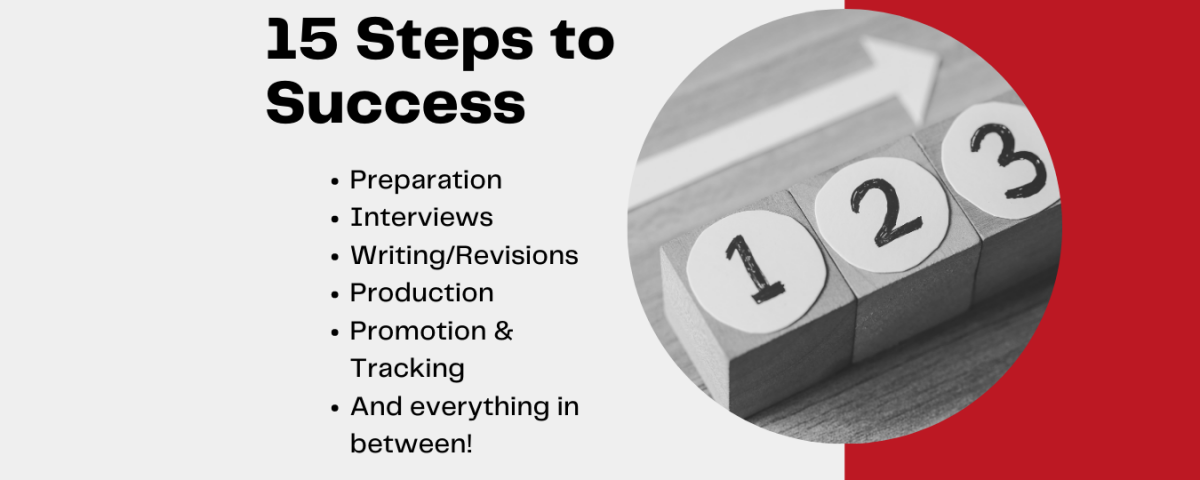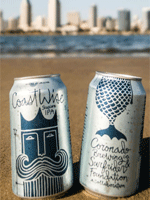How to Develop a Great Marketing Case Study

How to Show Compelling Results in Your Case Study
September 20, 2019
How to Make Your Marketing Case Study Anonymous Yet Effective
August 17, 2022There’s a lot more to creating a great marketing case study than just writing. It’s a whole process that includes goal setting, client selection, information gathering, design, and distribution.
As a case study writer, I’m involved in only one small part of the process. But my ability to produce a great case study involves many other factors, many of which are decided on before and after I’m pulled into the project.
I’ve broken down the process into several sections and 15 steps. Here’s what those look like:
Preparation
Before you assign a marketing case study to a writer, your organization has to lay the groundwork.
1. Nail down your case study objective
Begin by asking yourself why you need a case study in the first place. For example:
- What do you want to prove? That is, what case are you making for your audience?
- Have your customers asked to see case studies that support your claims?
- Have your salespeople been asking your organization to produce case studies?
- Do you want more leads, and if so, how many?
- Do you want more social media engagement?
- Do you need more content that presents your organization as a thought leader in your industry?
The main objective for any type of content marketing is to generate more business. Read Neil Patel’s blog post: Why You Need to Create Case Studies (a Data-Driven Answer).
2. Zero in on your case study audience
Ask yourself who would use the product or service you want to highlight and what pain points your solution addresses. Your case study needs to resonate with them to be effective.
For example, for a cybersecurity business I support, the audience differed for two different case studies.
- Audience 1: People interested in onboarding time. One case study focused on the onboarding process of working with the cybersecurity team, because that was a question the business received a lot from potential customers. The case study demonstrated how quickly and efficiently the company implemented cybersecurity tools, which would appeal to people with urgent deadlines.
- Audience 2: People interested in protecting company assets. This case study addressed the impact cybersecurity tools had on data security.
To sum up, knowing your audience helps you determine what to include in the case study, and what to leave out.
3. Choose your case study client carefully
You’ll want to select a client who’s not only ready to sing your praises, but whose story shows your solution and differentiators in the best light.
You also want someone who’s accessible and easy to work with. The more well-oiled your relationship with the client is, the more likely the case study will be published sooner rather than later.
Lastly, be sure your client is on board with a case study before you even start.
4. Identify your internal sources
Subject matter experts (SMEs) from your company will be the primary source for the case study. Select SMEs who are affable, well spoken, and comfortable explaining complex concepts.
In most cases, I speak to one source from the company that hires me and one source from their client’s company. However, some companies may want to expand the source list.
What I tell my clients is the more sources you include, the more time it takes to write and the more complicated the project becomes. It’s their prerogative, but it will increase the word count and the cost.
Video: 3 Traits Every Thought Leadership Source Should Have
5. Verify you’ve got good data or a compelling before-and-after story
The success of a case study depends on showing results. Results can be hard data, anecdotal evidence, a “We did it!” scenario, or a combination of these. Here’s what I mean.
- Hard data: Your client had zero data breaches in the last three months since you implemented new cybersecurity measures.
- Hard data: Your client experienced a 20% increase in sales after you helped them implement a new CRM.
- Anecdotal: Your client noticed a significant increase in sales inquiries after your company helped follow up on warm leads.
- We did it: You helped your client achieve regulatory compliance, which enabled them to continue doing business with the federal government.
- We did it and anecdotal evidence: You launched a new website for your client, which not only makes it easy for them to update and manage, but also improves their reputation (their employees are proud to share the new website on LinkedIn).
Each one of these examples is valid, because the result synchs up with the client’s reason for using your particular product or service.
Need help figuring out what’s good data? These blog posts might help:
- How to Show Compelling Results in Your Case Study
- 5 Examples of Great Case Studies You’ll Want to Emulate
6. Decide how quickly you need the case study

Some clients want a marketing case study for events, such as conferences or trade shows. Others want them for an upcoming client meeting.
If you’re starting from scratch, I allot about a month for just the text from start to finish, providing interviews are easy to schedule and revisions go quickly.
When a case study hinges on a date, that looming deadline creates a matter of urgency for the case study’s completion.
That means you have to ask yourself more questions to see if it’s feasible, such as:
- Will your ideal client be available for a case study interview?
- How long will the writing and review process take? In a perfect world, this takes me a little over 15 business days. That excludes the time it takes to schedule and conduct interviews and write an outline. Here’s how that breaks down:
- 5 days for writing
- 3 days to get revisions back from my client
- 2 days for me to revise that draft
- 5 days (or more) to get revisions from my client’s client
- 2 days to revise and produce the final document
- How long will it take to design the case study?
- If you need a PDF, a designer I work with estimates two to three weeks for design, which includes revisions.
- If you plan to place it on your website as a blog post, on your resources page or as a landing page, that’s much faster if you have a template or it doesn’t require fancy design.
Map those answers to your calendar, and you’ll see if the case study can be done in the time you require.
By the way, I have all sorts of sneaky ways of moving a project along, which you can read about in this blog post: The Zen of Case Studies: How to Finish Them on Time.
7. Assign the case study to a writer
Now that you’ve got all the information you need to move ahead on your marketing case study, you need someone to write it. The writer may be part of your team, or you may choose to outsource it to a freelance writer.
Here are four things you’ll want to look for:
- Writing ability: Does the writer have the writing chops needed for the task? If the writer is a whiz with social media and taglines but not adept at interviews, you might want to expand your search.
- Personality: Is the writer a good fit in terms of attitude and personality? For example, during a discovery meeting I had with a client via Zoom, he said he liked how I presented myself and that I was personable. This mattered to him, because I would be talking to his client, and I was a reflection of his brand. Writers who are taciturn or not comfortable drawing others out might not be the best choice for your project.
- Availability: Can the writer take on your project right now? Do they have other things on their plate that are a greater priority?
- Organizational/project management skills: Writing a case study isn’t just about writing. It’s about research, asking questions, following up, and collaborating. You need a writer who can wear the project manager hat, work well with people, and write well.
If you’re looking for a freelance writer, be sure to read these related blog posts:
- Do You Make These 3 Onboarding Mistakes with Freelancers?
- Practical Tips to Finding Freelance Content Writers
Interviews
These tasks pertain to the writer, but they are managed in tandem with your team. Since I’m the case study writer here, I’ll break down my process.
8. Interview someone on your team first
I always talk to you first to get the background and the main story. As part of the interview process, I do the following:
- Conduct additional research about your industry and gather information about your company by reviewing your website.
- Send questions in advance so you know what to expect.
- Record the interview, as well as the one with your client. I use this recording to generate a transcript.
The bulk of the case studies I’ve written are based on this initial interview. To use a sports analogy, you are the play-by-play commentator. You break down work you did for the client step by step.
The interview reveals the following:
- Your goals for the case study. What do you want to prove to your audience? Who is your audience? What is the primary messaging you want to convey to your readers?
- Your client’s goal for using your product or service.
- Your perspective on what your client’s pain points were.
- Details on how your product or solution addressed these pain points.
- Results that demonstrate you solved your client’s problem and achieved their goal.
If you or an SME have never been interviewed, this blog post is super helpful: 8 Tips to Help Executives Prepare for the Interview.
To use a sports analogy, you are the play-by-play commentator.
9. Interview the client
The interview with your client follows most of the same steps. The biggest difference between the two interviews is the type of information I get from your client. To use the same sports analogy, your client is the color commentator.
My goal, therefore, is to get your client to fill in information gaps, elaborate on those pain points, offer compelling examples, share data you don’t have, and provide great quotes.
Quotes, by the way, are essential to sharing your client’s authentic voice. To read more about quotes, take a look at this blog post: Why Your Case Study Needs Great Quotes and How to Get Them.
The client interview may be a long or short interview, depending on the length of the case study or how much information I get from my interview with you. However, I try to keep these to 30 minutes. Your clients are doing you a favor, so I want to be respectful of their time.
To use the same sports analogy, your client is the color commentator.
Writing/Reviews
When we think about writing case studies, we focus on the writing portion. But notice that we’ve gone through nine steps already, and nothing has been written yet.
That’s why I pointed out in the beginning of this post that case studies are as much about the planning as they are about the writing. For a case study project, the actual writing takes about a third of my time.
Here’s my case study writing process in a nutshell:
10. Produce an outline
Once I’ve completed both interviews, I create an outline for the case study — introduction, challenge, solution and results — and share it via Google Docs. The outline allows you to verify that the storytelling and the messaging are on target before I get started.
11. Write the case study
I follow the outline, adhere to the word count, and include a headline, subhead, and suggestions for callouts, sidebars and pullquotes. If I get stuck on anything, I send you questions via email. When I’m done, I send you the first draft of the case study.
I also make sure that every case study follows these guidelines:
- Written without fluff
- Highlights your client’s authentic voice
- Showcases the benefits of your product or service
- Provides some type of data
- Includes research (optional)
Get more information on what a case study should include: 5 Tips for Writing Great B2B Case Studies
12. Revise the case study
Most clients are comfortable using a collaboration tool like Google Docs to review the content and offer suggestions. The revision process works like this:
- First revision: Changes to the first draft usually entail messaging, terminology, and quotes.
- Second revision: After I incorporate your edits, I produce a second draft that goes to your client. To make sure the case study moves along, I always suggest giving your client a deadline for revisions. As for the review process, your client will most often change quotes and fine-tune their own company messaging.
- Third revision and final draft: Once I incorporate your client’s edits into the final draft. voilà! You now have the complete case study.
Now that you have the final version, the writer (if it’s a freelance writer) will exit the process.
Your internal writer, however, will most likely oversee the rest of the process, perhaps sharing the final with your client before the case study is mocked up, creating a call to action (if applicable) to include on the case study, and writing landing page copy if the case study is a downloadable.
For more information on how to write the case study, take a look at HubSpot’s How to Write a Case Study: Bookmarkable Guide & Template.
Production
13. Design and publish your case study
Your marketing/design or web development team will manage this process. Or you can outsource it.
Design may include creating a PDF and printing it and/or posting it online. A PDF is handy for sales to send to prospects after initial sales calls. It’s also excellent collateral for conferences and trade shows.
If you’re not going the PDF route, then you’ll design a webpage and post the case study there.
If you’re using the case study to collect leads online, you’ll need to create copy for the landing page. If not, you might just place the case study in a resources section or link to it from your blog.
How you proceed goes back to your original goal. Who is your audience? How will they access it? What action do you want them to take after reading the case study?
Examples of case study formats
Promotion and Tracking
14. Promote your case study
Now that your marketing case study is available, you can promote it in any number of ways: via your website, social media, newsletter, sales communications, conferences, tradeshows, etc. The list is endless.
15. Track ROI
This goes back to your original objective and what you wanted to achieve with a case study in the first place.
- How many leads did you generate through a case study landing page?
- How many leads did you generate by distributing the case study at a conference or trade show?
- How many sales did you close by sending a prospect a copy of the case study?
- How much engagement did you generate through comments, likes and shares via social media?
- Did the case study help position you as a thought leader through backlinks and citations from industry leaders and trade publications?
As you can see, developing a marketing case study more steps than assigning it to a writer. It takes forethought, goal-setting, project management, interview skills, an eye for design, and one final necessary step: verifying that it helped you achieve what your wanted.
Looking for a case study writer?
I’d love to hear about your project. Feel free to contact me.








